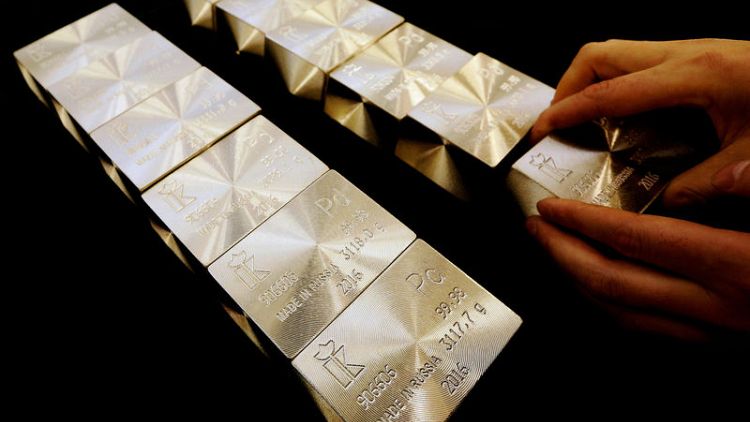By Peter Hobson
LONDON (Reuters) - A spectacular rally that last week took palladium to record highs has hit the buffers, with the metal plummeting almost 15 percent in three days this week.
But a gaping supply deficit will likely underpin prices despite signs that the market has become less tight.
Used in vehicle exhaust systems to curb harmful emissions, palladium almost doubled to a record $1,620.52 an ounce on March. 21 from $832 in August last year.
But by Friday it had tumbled back to around $1,375, and was on track for its biggest weekly loss since January 2016.
A correction was needed, said Commerzbank analyst Carsten Fritsch. "The price increase was off the charts and not justified by the fundamentals," he said.
GRAPHIC: Palladium price comparison - https://tmsnrt.rs/2CIUnAl
That view is bolstered by a shift in market conditions.
With the outlook for global economic growth increasingly gloomy, auto sales have slowed in key markets including China, the United States and Europe. The auto industry accounts for around 80 percent of palladium demand.
Meanwhile, palladium forward and lease rates, which leaped to around 30 percent in December and January, signalling an extreme shortage of metal, have pulled back to the low single digits.
GRAPHIC: Palladium forward rates - https://tmsnrt.rs/2CIShQZ
Backwardation -- a situation when metal for near-term delivery costs more than metal to be delivered later -- in the palladium market has prompted a rise in scrap and refinery supply, and South African producers have released stored material, said Scotiabank analyst Nicky Shiels.
"The entire general supply chain is finally responding to the backwardation with more output," she said. "The market is simply not as tight as it was three months ago (and) prices will recalibrate to reflect this."
The collapse in prices was sharpened by the small size and low liquidity of the palladium market, which amplifies price moves.
Automatic selling was also triggered after palladium crashed out of its seven-month uptrend and broke below its 50-day moving average.
GRAPHIC: Palladium technicals - https://tmsnrt.rs/2CMQOcx
But an ongoing supply deficit will support prices, analysts said.
"The market is still fundamentally tight," said Philip Newman, whose Metals Focus consultancy forecasts a 789,000-ounce shortfall this year in the 10 million ounce-a-year palladium market, and deficits of a similar size for several years after that.
"Once the dust settles, prices will start to recover," he said.
Analysts at Bank of America Merrill Lynch said earlier this month palladium prices would average $1,800 this year.
GRAPHIC: Palladium supply-demand balance - https://tmsnrt.rs/2CLRfDQ
The fall in lease rates has helped end drawdowns from exchange traded funds (ETFs), which had been a valuable source of metal for the market.
Investors had been taking palladium from ETFs in order to lease it out for higher returns, Shiels said.
GRAPHIC: Palladium ETF holdings - https://tmsnrt.rs/2WtLq5u
And even if auto sales slip, tightening emissions standards mean more metal is used in each vehicle, keeping demand high.
New regulation entering force in China, the biggest auto market, from 2020 will require each vehicle to contain around 30 percent more palladium, platinum and rhodium, according to analysts at Morgan Stanley.
The risk that auto makers will substitute palladium for platinum, which at around $850 an ounce is now far cheaper, has not yet materialized and would in any case happen slowly, analysts say.
The relatively low level of speculative investment in palladium shows that the rally was driven by industrial users of metals and is not a financial bubble, said ICBC Standard analyst Marcus Garvey.
GRAPHIC: Palladium speculative positioning - https://tmsnrt.rs/2CGVtN4
"The (price) correction doesn't change the fundamental market dynamics, it just changes the very short term perception," he said, predicting prices of around $1,500 at the end of 2019.
(Reporting by Peter Hobson; Editing by Veronica Brown and Jan Harvey)



